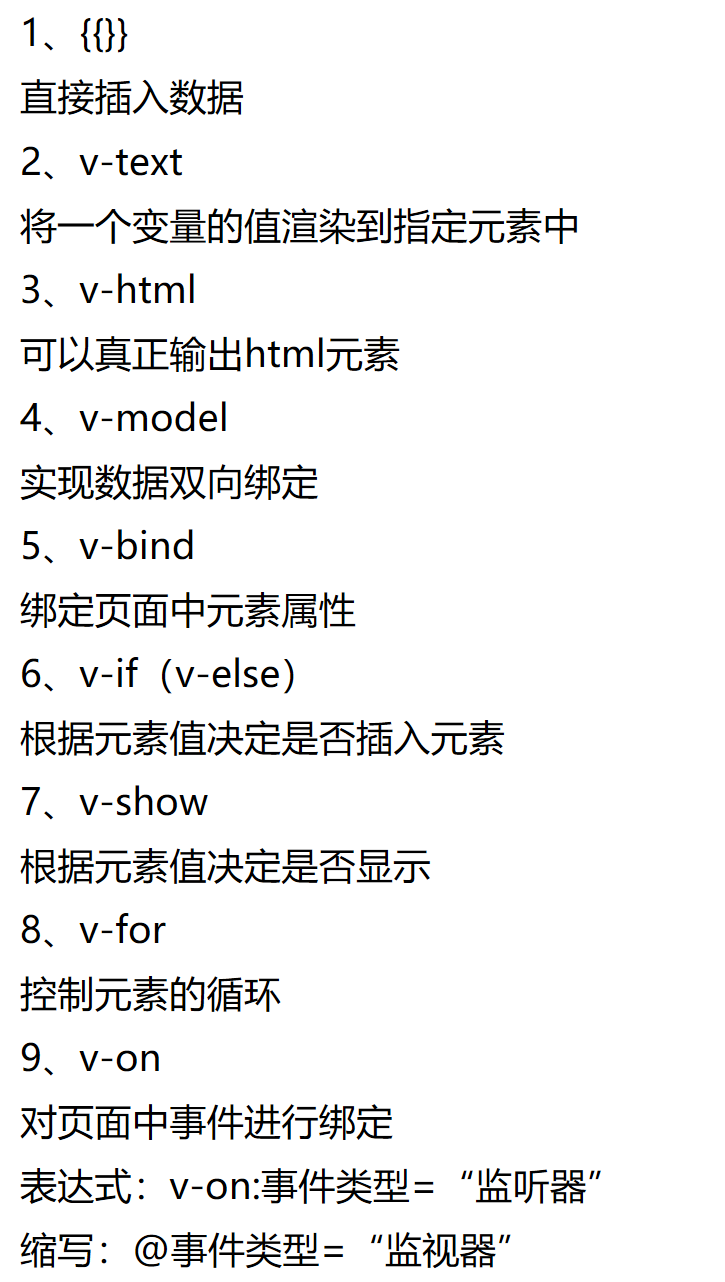<!DOCTYPE html> <html> <head> <meta charset="utf-8"> <title>Vue 测试实例</title> <script src="https://cdn.staticfile.org/vue/2.2.2/vue.min.js"></script> <script src="https://cdn.staticfile.org/vue-router/2.7.0/vue-router.min.js"></script> </head> <body> <div id="app"> <!--测试指令--> <p v-if="seen">测试v-if</p> <p v-else>测试v-else</p> <p v-show="show">测试v-show</p> <ul> <li v-for="fors in test_for">{{fors.number}},{{fors.name}}</li> </ul> <p v-on:click="myclick">点击我</p> <p @click="myclick">快捷点击方式</p> <!--复选框绑定,测试v-model--> <input type="checkbox" id="runoob" value="Runoob" v-model="checkedNames"> <label for="runoob">Runoob</label> <input type="checkbox" id="google" value="Google" v-model="checkedNames"> <label for="google">Google</label> <input type="checkbox" id="taobao" value="Taobao" v-model="checkedNames"> <label for="taobao">taobao</label> <h3>复选框选择内容: {{checkedNames}}</h3> <!--1.1调用组件--> <div id = "reallytemp"> <temp1></temp1> </div> <!--1.2组件间传值:1、父组件传值给子组件,2、子组件传值给父组件--> <!--1.2.1、父组件传值给子组件--> <div> <temp2 :value1='fathervalue'></temp2> </div> <!--1.2.1、父组件传值给子组件--> <div> <temp3 v-on:send='getData'></temp3> </div> <!--1.2路由的使用--> <div> <router-link to='/login'>登录</router-link> <!--路由传值--> <router-link to='/register/liuhui'>注册</router-link> <!-- 路由匹配到的组件将渲染在这里 --> <router-view></router-view> </div> </div> <!--1.1测试组件,定义组件--> <template id="temp"> <div> <h3 v-on:click="login">测试组件 {{msg}}</h3> <a href="" >账号</a> <a href="">密码</a> </div> </template> <!--1.2.1子组件,定义组件--> <template id="fathToson"> <div> 父组件传值给子组件,显示结果:{{value1}} </div> </template> <!--1.2.2子组件,定义组件--> <template id="sonTofath"> <div> <h3 @click="sendData">子组件点击发送数据给父组件</h3> </div> </template> </body> <script type="text/javascript"> Vue.component('temp1',{ //temp1为后续调用模板的标签名 template:'#temp', //对应模板的id data:function(){ //此处data的显示和之前的方式不同,采用函数返回的方式 return { msg:'信息显示' } }, methods:{ login:function(){ console.log("点击") } } }) //1.2.1 Vue.component('temp2',{ template:'#fathToson', //接受数据 props:{ value1:String //如果传入值为数字,则为number } }) //1.2.2 Vue.component('temp3',{ template:'#sonTofath', methods:{ sendData(){ this.$emit('send',123) //第一个参数对应父组件中v-on绑定的函数名称,第二个参数为发送内容 } } }) //路由的使用 //1、定义根组件 var rootapp = Vue.extend() //2、定义注册和登录组件 var login = Vue.extend({ template : '<h3>您已进入登录页面</h3>' }) var register = Vue.extend({ template : '<h3>您已进入注册页面,注册明为{{receivename}}</h3>', //路由传值设定 data :function(){ return { receivename : '' } }, created:function(){ this.receivename = this.$route.params.uname } }) //3、定义路由并且注册路由规则 var vueRoute = new VueRouter({ routes : [ {path:'/',redirect:'/login'}, {path:'/login',component:login}, {path:'/register/:uname',component:register} ] }) //4、使用路由,加入route,见下面 new Vue({ el: '#app', data: { seen: false, show:false, test_for:[ {number:1,name:"qq"}, {number:2,name:"qqq"}, {number:3,name:"qqqq"}, {number:4,name:"qqqqq"}, ], checkedNames:[], fathervalue:'父组件的值' }, methods:{ myclick:function(){ console.log("我被点击了") }, getData:function(tag){ console.log(tag) } }, router : vueRoute }) </script> </html>
基本指令

2、代码中包含调用组件,父组件传值给子组件,子组件传值给父组件,以及使用vue路由,和路由间传值